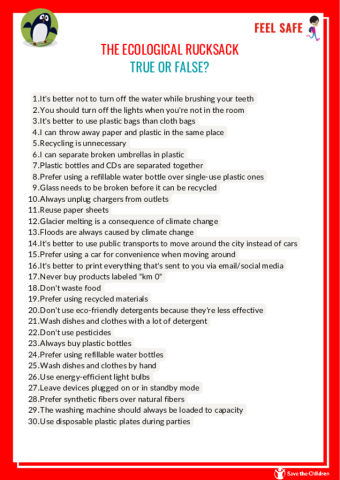The Ecological Rucksack
Objectives:
- Develop sustainable consumption habits to reduce environmental impact
- Get to know the concept of ecological backpacking and its meaning
- Analyse the consequences of the environmental impact of everyday choices
STEP BY STEP
Before starting
The teacher introduces the concept of the 'ecological rucksack' and asks the class what comes to their minds when they hear about it. Inputs can be collected on the blackboard.
At the end of the brainstorming session, the teacher draws a large rucksack on the blackboard, containing several books. They then invite the children to imagine what they feel when they look at it, or what they would feel if they had to carry it on their shoulders.
The weight they will feel is exactly the basis of the concept of an ecological rucksack. In fact, in the metaphor we find the rucksack (the environment) and the weight of the books (our consumption), so the greater the weight, the greater our consumption.
What does this rucksack represent?
The ecological rucksack measures in kilos the load of nature that each product or service carries on its 'shoulders' in an invisible rucksack and is calculated by subtracting the weight of the materials we have taken from nature to make that product or service from the weight of the product itself.
In other words, the ecological rucksack is nothing more than "an indicator that includes all the resources used for production, transport between factories and transport from the factory to the consumer".
For example, when we throw away a pound of paper, we are normally inclined to think that we have only thrown away that pound of paper. In reality, we are throwing away much more, because behind that paper there is a paper mill, and before that there is the cutting of wood, the use of fuel for transport, the energy for treatment and processing, the wear and tear on machines, water and much more.
But what are the phases of a product's life cycle?
- Pre-production, i.e. design, research, development, selection and purchase of raw materials, transport and storage;
- Production, i.e. processing of materials, assembly and finishing, management and organisation;
- Distribution, i.e. the logistics and sale of the product;
- Consumption, i.e. utilisation and use (also as an intermediate product)
- Disposal, i.e. end-of-life management, reuse, recovery phase in the risk management cycle that involves the removal of all possible obstacles to facilitate the resumption of normal living conditions , recycling.
After having fully understood the concept of an ecological rucksack, the teacher invites the class to measure their own ecological footprint, using the Calculator (link). Afterwards, the teacher will facilitate a brief discussion/reflection on the data that has emerged and the answers given.
True or false?
The teacher introduces the game activity. The class is divided into two groups, each of which will have to choose what their team name will be. Once this is decided, all members of each team line up in one line.
Each team has three minutes to answer questions about daily habits (see attached "True or False? - The Ecological Rucksack" below). At the start of each round, the teacher will start the timer and ask the first person in line the questions. In the event of a wrong answer, the turn passes directly to the next teammate in line, beginning again with question number 1.
The team that successfully answers the most questions in the three minutes available wins.
Concluding thoughts
At the end of the game, the teacher brings everyone back to the plenary.
In conclusion, he or she makes us reflect on the importance of starting with small daily gestures to safeguard the environment and to leave our virtuous footprint for the environment. With small gestures and sustainable behaviour, we can help reduce our impact on the environment.
Some examples of sustainable behaviour are shared:
- Favour cycling or public transport for travel
- Eat fruit and vegetables in season
- Remember to turn off the light when you leave a room and do not leave your PC or TV on stand-by when you are not using them
- Sort your waste properly
- Favour recycled materials and avoid disposable items
- Prefer a shower to a bath or turn off the taps while brushing your teeth
At the end of the reading, each child thinks about what small 'virtuous' action he or she intends to carry out from now on.

Add new comment